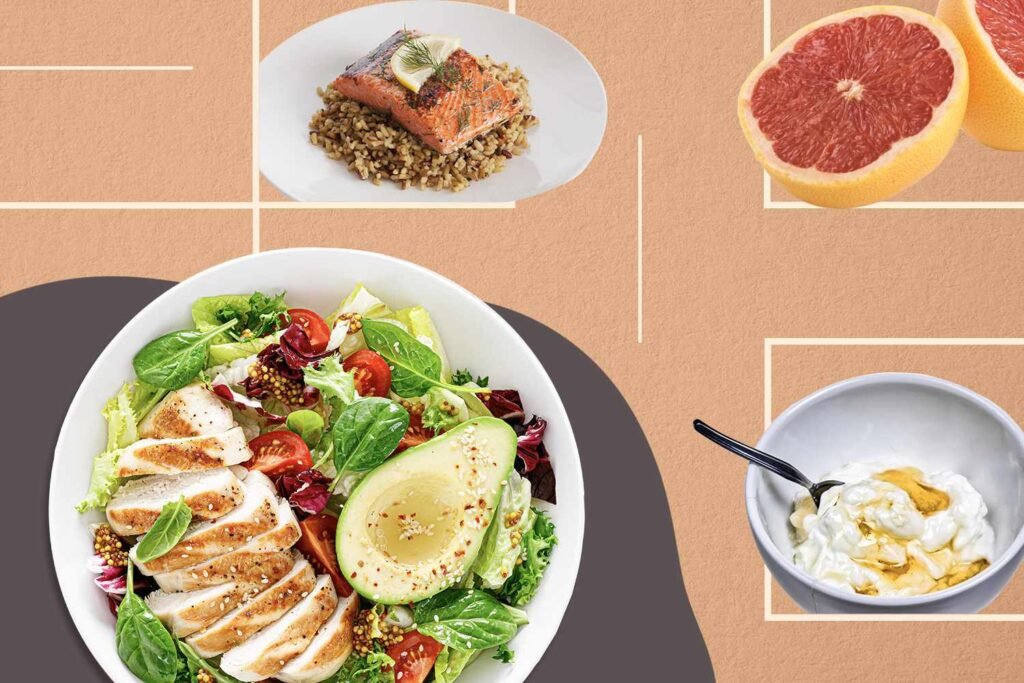Healthy Eating Meal Plan: Your Comprehensive Guide to Balanced Nutrition
Welcome to your ultimate guide on healthy eating meal plans! Whether you aim to improve your well-being, manage your weight, or simply enjoy delicious and nutritious meals, this guide is designed for you. We’ll explore everything you need to create a successful meal plan, providing practical tips and insights into balanced nutrition. So, let’s embark on this journey towards a healthier lifestyle together!

What Makes a Meal Healthy?
A healthy eating meal plan isn’t just about visual appeal; it’s about providing your body with the right nutrients to function optimally. Think of a healthy meal as a balanced equation of essential nutrients: proteins, carbohydrates, fats, vitamins, and minerals. A healthy eating meal plan is a meticulously organized framework designed to promote balanced nutrition and overall well-being by strategically incorporating a diverse array of nutrients into your daily diet
Components of a Healthy Meal
To construct a healthy meal, aim for a balanced plate that includes:
- Lean Proteins: These help build and repair tissues. Options include chicken, fish, tofu, and legumes.
- Complex Carbohydrates: These provide sustained energy. Examples are whole grains like quinoa, brown rice, and oats.
- Healthy Fats: These support cell function and provide energy. Sources include avocados, nuts, seeds, and olive oil.
- Fruits and Vegetables: These are rich in essential vitamins, minerals, and fiber.
For example, a well-rounded meal could be a grilled chicken breast served with a side of quinoa, steamed broccoli, and a fresh fruit salad. This combination offers a good balance of protein, fiber, and essential nutrients.
The Importance of a Balanced Diet
A balanced diet ensures that you receive a wide range of nutrients necessary for overall health. Just like a symphony, every food group plays a crucial role in maintaining well-being.A balanced diet is crucial for maintaining overall health by providing essential nutrients in the right proportions.
It supports bodily functions, boosts energy levels, promotes healthy growth, and helps prevent chronic diseases. Proper balance ensures that all dietary needs are met, contributing to optimal well-being and disease prevention.

Why Balance Matters
- Nutrient Variety: Each food group provides different vitamins and minerals. For instance, dairy products offer calcium for bone health, while leafy greens provide iron.
- Energy Levels: Carbohydrates supply your body with energy, proteins help build and repair tissues, and fats provide long-lasting energy and support brain function.
Creating meals with a mix of lean proteins, whole grains, and plenty of vegetables ensures you meet your nutritional needs and helps you feel satisfied. For example, a hearty lentil stew with vegetables and a side of brown rice combines various nutrients in one meal.
Effective Meal Planning Strategies
Effective Meal Planning StrategiesHealthy eating Meal planning is a strategic approach to organizing your meals, making healthy eating more manageable. It involves creating a weekly menu, preparing meals in advance, and ensuring you have all the necessary ingredients.
How to Get Started
- Weekly Menu: Set aside time each week to plan your meals. Choose recipes that align with your nutritional goals and are practical to prepare.
- Preparation: Cook ingredients in bulk when possible. For example, preparing a large batch of roasted vegetables or whole grains can save time during the week.
- Grocery Shopping: Make a shopping list based on your meal plan to ensure you have all the ingredients you need.
By organizing your meals and preparing ingredients in advance, you reduce the likelihood of resorting to unhealthy convenience foods and make healthy eating a more natural part of your routine.
Nutrition Tips for Daily Success
Sticking to a healthy eating meal plan involves more than just choosing nutritious foods—it requires smart strategies to support your goals. Here are some practical tips:
Daily Tips for Success
- Stay Hydrated: Drink plenty of water throughout the day. Proper hydration helps control hunger and supports overall bodily functions.
- Incorporate Fiber: Include high-fiber foods like fruits, vegetables, and whole grains in your diet. Fiber helps keep you full and supports digestive health.
- Mind Your Portions: Use smaller plates and be mindful of portion sizes to avoid overeating. Paying attention to portion sizes can help you manage calorie intake and maintain a healthy weight.
Following these tips helps you manage appetite, improve digestion, and maintain a balanced diet.
Crafting a Meal Plan That Fits Your Lifestyle
A healthy eating meal plan should be tailored to fit your lifestyle and dietary needs. Consider your daily routine, cooking preferences, and specific health goals when designing your plan.Crafting a meal plan that fits your lifestyle involves creating a customized approach to nutrition that aligns with your daily routines, preferences, and health goals.
To begin, assess your typical week to understand your schedule, cooking abilities, and eating habits. Consider whether you have the time to prepare meals daily or if batch cooking and meal prepping might be more practical.
- Assess Your Routine: Determine how many meals you need to prepare each week. If you’re cooking for a family, consider their preferences and dietary needs.
- Set Goals: Align your meal plan with your health objectives. For weight loss, focus on low-calorie, nutrient-dense foods. For muscle gain, emphasize high-protein and healthy fat options.
Adapting your meal plan to suit your lifestyle and goals ensures it’s both practical and effective.
Personalizing Your Plan
The Role of Portion Control in Healthy Eating
Portion control is essential for managing your calorie intake and maintaining a balanced diet. Even healthy foods can contribute to weight gain if consumed in large quantities.
Strategies for Portion Control
- Use Smaller Plates: This visual trick can help you eat smaller portions and avoid overeating.
- Understand Serving Sizes: Familiarize yourself with recommended serving sizes and read nutrition labels to make informed choices.
Practicing portion control allows you to enjoy a variety of foods while keeping your calorie intake in check, supporting weight management and overall health.
Adding Variety to Your Meals
Eating a diverse range of foods helps prevent boredom and ensures you get a broad spectrum of nutrients. Variety also keeps meals interesting and satisfying.
How to Add Variety
- Experiment with Recipes: Try new recipes and ingredients regularly. For instance, swap out your usual chicken for grilled shrimp or experiment with different vegetable combinations.
- Explore Cuisines: Incorporate foods from various cuisines to add new flavors and nutrients to your diet.
Adding variety to your meals not only makes eating more enjoyable but also ensures you receive a wide range of essential nutrients.
Adapting Your Meal Plan to Dietary Restrictions
If you have dietary restrictions or preferences, such as being vegetarian or gluten-free, adjust your meal plan to accommodate these needs. There are many nutritious alternatives available.
Adjusting for Restrictions
- Vegetarian Options: Include plant-based proteins like beans, lentils, and tofu in your meals. Ensure you’re getting enough iron and vitamin B12 from fortified foods or supplements.
- Gluten-Free Choices: Use gluten-free grains like quinoa, rice, and gluten-free oats instead of wheat products. Check labels for hidden sources of gluten.
Adapting your healthy eating meal plan ensures you can maintain a healthy diet while meeting your dietary needs and preferences.
Staying Motivated with Your Meal Plan
Maintaining motivation is key to sticking with your meal plan. Setting goals and celebrating milestones can keep you engaged and focused.
Tips for Staying Motivated
- Set Achievable Goals: Create small, manageable goals and reward yourself for reaching them. For example, if you stick to your meal plan for a month, treat yourself to a new kitchen gadget or a special outing.
- Share Your Goals: Involve friends or family members in your meal planning process. Sharing your journey can provide additional support and make the experience more enjoyable.
Regularly reviewing and adjusting your healthy eating meal plan based on your progress and changing needs helps keep you motivated and ensures continued success.
Regularly Reviewing and Adjusting Your Plan
A successful meal plan requires periodic review and adjustment. Regular evaluations help ensure that your plan remains effective and aligned with your goals.
How to Review and Adjust
- Monitor Progress: Assess how you feel and whether you’re meeting your dietary objectives, such as improved energy levels or weight management.
- Make Adjustments: If necessary, tweak your meal plan by incorporating new recipes or adjusting portion sizes to better meet your needs. Also read this Teenage Health Workshops
Flexibility is key to maintaining a sustainable meal plan that supports your ongoing health and well-being.

Conclusion
Creating and maintaining a healthy eating meal plan involves careful consideration of your nutritional needs, preferences, and goals. By following the strategies and tips outlined in this guide, you can develop a healthy eating meal plan that supports your well-being, keeps you engaged, and integrates healthy eating into your lifestyle. Remember, the journey to better health is a marathon, not a sprint. Stay committed, be patient, and enjoy discovering new and delicious ways to nourish your body.
This comprehensive guide provides valuable insights and practical tips for developing a healthy eating meal plan, tailored to fit within the 1700-word limit while covering essential aspects of balanced nutrition and meal planning,
- What defines a healthy eating meal plan?
A healthy eating meal plan involves organizing balanced meals that provide essential nutrients for overall well-being. - How can meal planning improve nutritional intake?
Meal planning helps ensure consistent consumption of nutritious foods, supporting better health and weight management. - What are the core components of a balanced meal?
A balanced meal includes lean proteins, whole grains, healthy fats, and a variety of fruits and vegetables. - Why is portion control important in a meal plan?
Portion control helps regulate calorie intake and prevent overeating, which supports weight management and overall health. - How can variety enhance a meal plan?
Incorporating variety keeps meals interesting and provides a broader range of nutrients, promoting better overall nutrition.




Post Comment